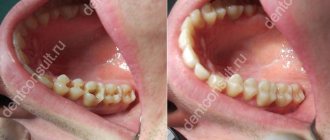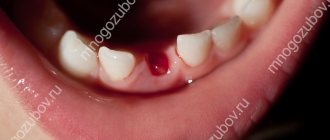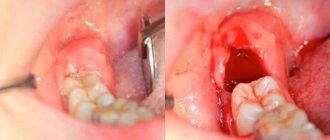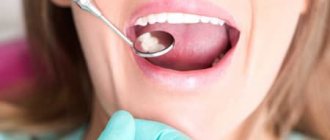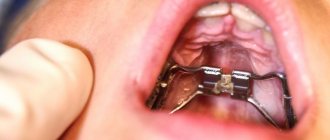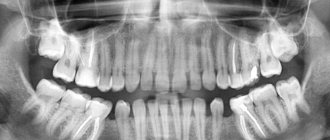Warning: bleeding!
- Have you had a tooth removed or other surgical intervention in the oral cavity? Remember: you can eat food only after 2 hours, and drink no earlier than after 40 minutes.
- Refrain from rinsing your mouth (unless, of course, there were any recommendations from your doctor) so as not to disrupt the integrity of the blood clot that forms at the site of the wound and promotes its healing.
- Normally, bleeding from the wound should stop about an hour after surgery. If the wound begins to bleed again after a while, tightly roll up a piece of sterile bandage, apply it to the wound and bite it. Does the bleeding continue for more than 2 hours? Contact your dentist for help.
Precautions after tooth extraction
The patient’s behavior after the procedure determines the further healing process of the wound in the mouth. Tooth extraction is a serious manipulation, so experts recommend observing the following restrictions:
- Remove the tampon from the hole before 25-30 minutes
If the operation to extract a tooth is successful, the bleeding is stopped by inserting a tampon into the hole. There is no need to remove it before, nor do you need to remove it by hand. Even on clean hands there are many microbes that, upon contact, will penetrate into the oral cavity and cause infection of the hole. It is enough to spit out the tampon (cotton wool).
- Rinse your mouth for the first couple of days after surgery
This ban may seem to many to be a mistake, because treating a wound is, in fact, considered commonplace. However, such procedures prevent the formation of a blood clot at the site of the extracted tooth. Therefore, it should be carried out only with the advice of a doctor. The process itself is performed carefully, without intense exposure to a jet of liquid on the well. It is enough to take the solution into your mouth and hold it in the wound area for 5-7 minutes, then spit it out.
- Smoking and drinking alcohol
When smoking after a tooth has been pulled out, the harmful tars contained in tobacco get onto the open wound of the oral cavity. And alcoholic drinks, or more precisely the ethyl alcohol from which they are produced, irritate sensitive areas and the socket. In addition, under the influence of alcohol, the blood clot is washed out of the hole, which deprives the wound of its protective layer. Bad habits increase the chances of developing infectious diseases and inflammation in the oral cavity.
- Consume foods made from fermented milk products
The presence of open wounds in the mouth requires the exclusion of fermented milk products from the menu. An acidic environment creates favorable conditions for the development of pathogenic microflora, resulting in inflammation of the oral tissues.
- Do sports or hard work
Physical activity increases blood circulation, which can cause bleeding from the socket. Prolonged healing of the wound creates a favorable environment for the development of complications, which are always more difficult to cure.
- Expose the body to hypothermia or overheating
Overheating or hypothermia of the body ends in inflammation. In this case, the process of tissue cell regeneration is extended over a long period. Inflammation is a provoking factor in the development of more serious problems in the oral cavity.
Brief instructions: how to quickly restore health the next day
After the removal procedure, you should not remove the gauze pad placed by the dentist until the bleeding stops (usually this takes from 20 minutes to an hour). The first action is to apply cold to the projection of the extracted tooth (after consulting with the dentist). You need to apply ice about 3 times for 15 minutes, avoiding hypothermia.
We suggest you familiarize yourself with After tooth extraction - if the tooth and gums hurt after removal, rules of conduct for preventing complications, what to do after wisdom tooth removal, how many days does the socket heal?
To prevent pain, you can take painkillers such as Analgin, Ketanov, Nurofen and Nimesil. You should not eat until the anesthesia wears off. After complex removal, it is recommended to eat soft and liquid foods for 24 hours. Antiseptic rinses are allowed from 2 days. And also from the 2nd day, antiseptic baths using a solution of Chlorhexidine (0.05%) or herbal decoctions are allowed.
Attention! If you experience severe discomfort, stiffness or pain when opening your mouth 24 hours after surgery, you should immediately contact your dentist.
A tooth hurts after a filling: what to do, causes and treatment
Filling is one of the simplest and most common dental procedures. Almost everyone has to go through it. Most often, filling is used in the treatment of caries, pulpitis, periodontitis, cysts and phlegmon. All these diseases are characterized by aching or acute pain. Sometimes it is permanent, sometimes it occurs only when pressure is applied to the diseased tooth. In the event of such ailments, dentists are usually contacted only when the toothache becomes completely unbearable. It is clear that after contacting a specialist, everyone hopes that the pain will go away immediately upon completion of treatment, but, unfortunately, sometimes this is not the case at all. Some patients return to the clinic within a couple of days with the complaint: “The tooth hurts after the filling.” Why does such an unpleasant symptom occur and how to deal with it?
Caution, anesthesia!
- Modern anesthetics used for pain relief during dental treatment or before oral surgery can temporarily slow down the reaction, impair coordination of movements and cause headaches. Therefore, when returning home, be careful when crossing the road or going down the escalator to the metro. To avoid trouble, do not drive a car in the first hours after visiting the dentist.
- Be aware: the sensitivity of the tissues in the mouth under the influence of the injection is reduced. Avoid hot drinks and food for 3-4 hours: you may get burned and will not feel it in a timely manner.
- Often, only after the end of the anesthesia, you can understand that the installed filling or crown interferes with biting, scratches the cheek or puts pressure on neighboring teeth. To prevent such discomfort from a healed tooth from causing serious damage, consult your doctor in a timely manner.
We invite you to familiarize yourself with Tongue for gastritis and stomach ulcers photo
Reminder after implantation
So, you need to remember the following:
- The oral cavity requires constant and careful care. Regular gentle rinses and antiseptic baths in the mornings, evenings and every time after meals. Gently brush with a soft brush 3 times a day.
- Swelling, numbness, temperature and pain after implantation should go away within 5 days. There should be no sharp pain or high temperature (above 38 degrees). Otherwise, consult a doctor.
- You must take all medications prescribed by your doctor regularly.
- You should not drink alcohol or smoke for at least 2 weeks after implantation. Subsequent smoking will void the warranty.
- Sports and physical activity are contraindicated for 2 weeks.
- No saunas, steam baths, swimming - overheating and hypothermia are contraindicated
- In the first week, only soft food, chew not on the side of the implants
- No spicy, sour or hard foods
- You cannot drink hot or cold drinks or coffee of any kind.
Home » Bicortical implantation » REMEMBER FOR THE PATIENT AFTER IMPLANTATION
Plans for the week
- A slight swelling near the wound and mild pain in this area after surgery should not scare you. They usually disappear on the second or third day. You can alleviate the condition and relieve pain with the help of analgesics. It is best to relieve swelling with a cold compress, which, by the way, also acts as an additional pain reliever. To do this, periodically apply an ice pack to the outside of your cheek for an hour for 10–15 minutes, taking breaks of the same duration.
- Brush your teeth slowly, carefully avoiding the area where the wound is located. During this period, it is best to use a brush with soft bristles.
- Postpone sports, going to the bathhouse, swimming pool, or solarium until you have fully recovered, so as not to provoke resumption of bleeding from the wound, as well as to avoid getting microtrauma or “catch” an infection.
- Has your health worsened during the day - your temperature has risen above 37.5 degrees, throbbing pain has appeared and swelling has increased? Urgently hurry to see your doctor.
Sedation
Depending on your oral surgeon and what procedure you are having, you may need to take it easy to reduce anxiety and numbness in your mouth. One type is a narcotic analgesic such as codeine or hydrocodone. It works directly within your central nervous system to relieve pain.
You may be given one before or immediately after the procedure. Exercise is not recommended until the narcotic analgesic has completely worn off, which can be up to 12 hours, depending on the dosage. A local anesthetic is a general anesthetic and numbing agent that is injected into the affected area before procedures such as extractions or fillings; this usually lasts two to four hours after administration.
Some dentists and surgeons use nitrous oxide or laughing gas to calm patients before starting a procedure. The effects of nitrous oxide calm you down so you don't have to drive home. General anesthesia is used with difficult extracts or small children who cannot remain still - this induces sleep and unconsciousness during the procedure, so you should get someone to be responsible to drive you home afterwards because you may have remained clumsy in for several hours afterwards.
We suggest you read: Where does bad breath come from and how to get rid of it?
Dental procedures
There is a wide range of procedures that you could have done at your dentist or ophthalmologist. These range from light cleaning to extraction or root canal. If you have something that doesn't require sedation or non-invasive, such as an oral exam or x-ray, you can practice right after.
If you have dental work that involves removing teeth, gum, or bone, you will follow your dentist's instructions carefully. The main thing is to make sure that your stitches or blood clots on your gums do not stand out or fall out - this can lead to further complications, including infection. If you have a cap or crown on your teeth, you may want to refrain from strenuous exercise for three to five days after the procedure.
For what reasons could pain occur after a filling?
In most cases, after a filling, a tooth hurts due to some shortcomings of the specialist. However, it cannot be said that such shortcomings can be considered serious medical errors. When treating many diseases, it is simply impossible to fully assess the whole picture the first time, and it is simply impossible to carry out in-depth diagnostics for every caries. Otherwise, the queues at the dental office will not move for several hours. The most common causes of severe pain after dental filling are:
• Incomplete treatment.
During the treatment of caries, tissue affected by the disease could remain. The same applies to pulp removal. Sometimes, without an x-ray examination, it is not possible to completely remove it. In some people, during the process of growing their molars, the roots become very curved, this especially often occurs when the dentition is severely crowded. The dentist during the endodontic treatment could simply not have noticed this, and part of the nerve ending remained in the canal. Immediately after the anesthesia wears off, it will begin to cause severe pain to the patient.
• Part of the filling composition goes beyond the root apex.
Recently, such a complication of the treatment of endodontic diseases is very rare. In the arsenal of modern dental clinics there are gutta-percha pins, with the help of which the root canal is closed after pulp removal. Only upon completion of this stage of tooth restoration is filling material applied. If the dentist did not use a pin through the natural hole in the root of the tooth after removing the nerve, the filling compound may extend beyond the apex of the root. Then it will end up in the mucous membrane and the body will immediately recognize the foreign body. Inflammation occurs and pain appears. It becomes very difficult to remove excess filling composition in the aftereffect. To do this, you have to cut through the outer part of the gum.
• Foreign objects.
Failure to follow certain rules for using dental instruments can result in very unpleasant consequences. For example, when removing pulp, a very thin instrument is used and if you press on it a little harder than necessary, it will break very easily. It’s good if the dentist immediately discovered this problem and removed the foreign object from the canal in time, but sometimes the fragments of the instrument are so small that you can’t even pay attention to it. After filling, the foreign object rejection reaction begins again, and the person feels severe pain.
• Perforation of the tooth root.
Here again we will talk about those instruments that are used to remove pulp. Relatively recently, specialists have come into use with devices with a rotating mechanism, which reduce the time spent on an operation several times and increase the likelihood of errors by the same amount. If you press the tool hard, it can pierce the root. In this part of the tooth, the tooth is not protected by the same strong enamel as its crown, so root perforation is not so rare. When the lower part of the tooth is pierced, the mucous membrane also suffers. Therefore, pain appears immediately after surgery. If the damage to the root is too severe, it even has to be removed, and the lost part of the tooth is restored using a crown or composite restoration.
Types of exercises
If you've had a lot of dental work, your body will tell you to take it easy and when you feel the workout. Even if you have a lot of energy, you should still exercise caution—especially the day of surgery and the next few days. The key is to avoid vigorous activity or movement—keep it moving and not jarring.
https://www.youtube.com/watch?v=FtNQ0Atl3FE
One way you can do this is with range of motion, or ROM, exercises. ROM helps your joints and muscles by keeping them flexible and healthy, while also having low impact on your jaw and head area. The exercises involve repeatedly moving the shoulders and arms in synchronized movements to improve blood flow.




